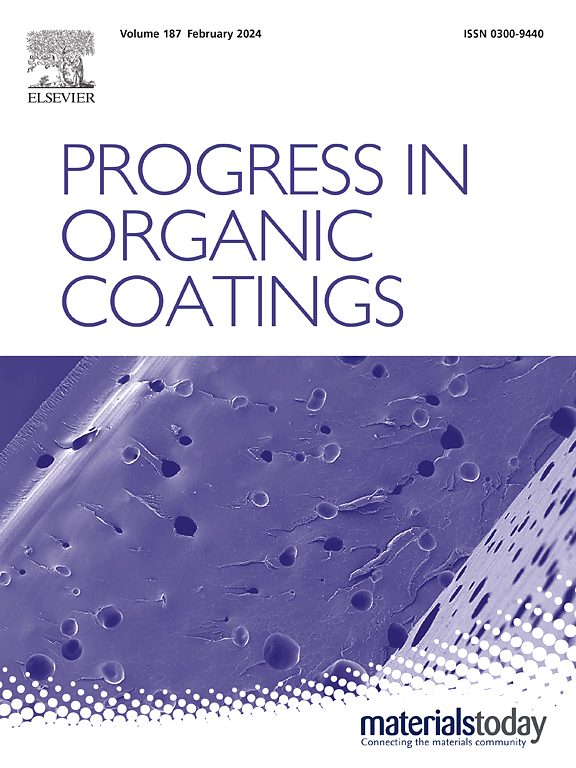水性双官能团三聚氰胺树脂涂料的快速紫外线/热固化及其优异的功能性
IF 6.5
2区 材料科学
Q1 CHEMISTRY, APPLIED
引用次数: 0
摘要
三聚氰胺树脂涂料(MF 涂料)通常采用热固化(TC)或酸/热固化(ATC)方法固化。这种固化方法存在操作繁琐、固化速度慢、易收缩、脆性大等缺陷,阻碍了三聚氰胺树脂涂料在涂装领域的实际应用。本文设计并制备了一种具有双官能团结构(烯丙基和羟甲基)的水性三聚氰胺树脂低聚物(dMFO)。通过 "紫外/热 "固化方法,dMFO 可以快速凝胶化,并获得具有优异功能性的固化 MF 涂料。结果表明,当光引发剂 1-羟基-环己基苯基酮(Pi184)的用量为 dMFO 质量的 3%时,中频涂层可在约 11 分钟内固化。涂层的拉伸强度达到 8.24 MPa,抗冲击高度为 180 mm,附着力高达 5.51 MPa,铅笔硬度为 5H,水接触角可达 113°,耐水性超过 14 h,极限氧指数为 30.87 %。用 dMFO 制备的 MF 涂层具有结构韧性、自疏水性和本征阻燃性等优异特性。此外,MF 涂层还具有良好的自清洁性能、防腐性能和耐化学腐蚀性能。分析表明,MF 涂层具有由热塑性片段和热固性网络结构相互渗透形成的原位互穿网络结构(IPN)。这两种结构的分子链段之间的有效协同作用促进了中频涂层的结构优化和性能提升。本文介绍的工作为中频涂层的大规模应用奠定了关键技术基础,具有广阔的工业应用前景和巨大的商业价值。本文章由计算机程序翻译,如有差异,请以英文原文为准。
Rapid UV/thermal curing of waterborne difunctional-group melamine resin coating and its excellent functionality
Melamine resin coatings (MF coatings) are usually cured by thermal curing (TC) or acid/ thermal curing (ATC) method. That exists some defects such as operation cumbersomely, curing slowly, easy to shrink and brittle, etc., which hinders the practical applications of MF in the field of painting. In this paper, a waterborne melamine resin oligomer (dMFO) with a difunctional structure (allyl group and hydroxymethyl group) was designed and prepared. The gelation of the dMFO can quickly accomplish and obtain a cured MF coating with excellent functionality by the “UV/thermal “curing method. The results show that when the dosage of photoinitiator 1-hydroxy-cyclohexyl-phenyl ketone (Pi184) is 3 % relative to the mass of dMFO, the MF coating can be cured in about 11 min. The tensile strength of the coating reaches 8.24 MPa, the impact resistance height is 180 mm, the adhesion is up to 5.51 MPa, the pencil hardness is 5H, the water contact angle can reach 113°, the water resistance exceeds 14 h, and the limiting oxygen index is 30.87 %. The MF coating was prepared from dMFO displays excellent characteristics such as structural toughness, self-hydrophobicity, and intrinsic flame retardancy. In addition, the MF coating also has good self-cleaning performance, anti-corrosion property, and chemical corrosion resistance. The analysis suggests that the MF coating has an in-situ interpenetrating network structure (IPN) formed by the interpenetration of thermoplastic segments and thermosetting network structures. The effective synergy between the molecular chain segments of these two structures facilitates the structural optimization and performance enhancement of the MF coating. The work presented in this paper has laid a key technical foundation for the large-scale application of MF coatings, which holds promising prospects for industrial application and significant commercial value.
求助全文
通过发布文献求助,成功后即可免费获取论文全文。
去求助
来源期刊

Progress in Organic Coatings
工程技术-材料科学:膜
CiteScore
11.40
自引率
15.20%
发文量
577
审稿时长
48 days
期刊介绍:
The aim of this international journal is to analyse and publicise the progress and current state of knowledge in the field of organic coatings and related materials. The Editors and the Editorial Board members will solicit both review and research papers from academic and industrial scientists who are actively engaged in research and development or, in the case of review papers, have extensive experience in the subject to be reviewed. Unsolicited manuscripts will be accepted if they meet the journal''s requirements. The journal publishes papers dealing with such subjects as:
• Chemical, physical and technological properties of organic coatings and related materials
• Problems and methods of preparation, manufacture and application of these materials
• Performance, testing and analysis.
 求助内容:
求助内容: 应助结果提醒方式:
应助结果提醒方式:


